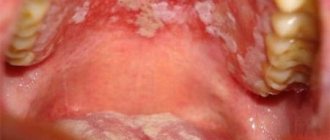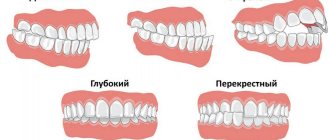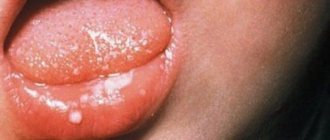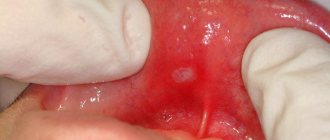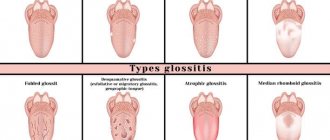What is a disease
Stomatitis is considered a lesion of the oral mucosa.
The reasons for the development of this pathology are:
- infection by infections (viruses, bacteria, fungi);
- medicines;
- autoimmune processes.
Children develop painful ulcers in their mouths. They are quite deep, but heal without scarring. If the baby has immune disorders, then the ulcerative process is continuous. Previously formed ulcers simply do not have time to heal before new ones appear. The acute process becomes chronic. That is why it is important that nutrition for stomatitis is gentle, at the same time complete and varied.
What is stomatitis and what types exist?
The name of the disease indicates its exact location; translated from Latin “stoma” means mouth. Stomatitis is an inflammatory lesion of the oral mucosa (most often ulcerative). Both adults and children can get sick. But the disease affects children more often. This is due to the fact that the mucous membrane at this age is easily infected by pathogenic microflora, because the child’s body is not yet perfect, local and general protective reactions are not sufficiently developed. Statistics show that almost 80% of young children have suffered from this disease at least once.
Stomatitis is the general name for a whole group of diseases of the oral mucosa. Therefore, each of them has its own symptoms and its own treatment methods. Depending on the etiology, stomatitis is divided into several types:
- viral, including herpes - has a viral nature, infection occurs by airborne droplets. The virus can exist on objects (clothing, toys, etc.) for some time. The initial symptoms are similar to those of ARVI: lethargy, fever, runny nose, cough (not always). On the second or third day, light ulcers with a red border appear on the tongue, mucous membranes of the cheeks and lips;
- traumatic - inflammation is provoked by mechanical damage to the inner surface of the mouth, for example, a burn from a hot drink or food, a scratch from a toy stuck in the mouth, biting if the child has an incorrect bite;
- allergic – the inflammatory process is provoked by the entry into the body of a substance that causes an allergic reaction. Most often caused by drugs;
- candidiasis (fungal) - begins when the mucous membrane is infected with the fungus Candida (“thrush”). A striking symptom is a dense white coating on the tongue.
General diet rules
A special feature of the diet for this oral disease should be food that is as neutral as possible and does not irritate the mucous membranes. It should be well crushed and have an enveloping and slimy consistency.
When organizing meals for a baby with this disease:
- It is necessary to adhere to small, frequent meals. Portions should be small, and the frequency of intake should be five or six times a day. It will be easier for the baby to eat a small portion, and it will be easier for parents to feed him.
- All food should be crushed as much as possible, and the consistency should resemble puree. Meat and fish are used only in the form of minced meat. The temperature of the food should not be higher than forty degrees, neither hot nor cold.
- Before eating, you can treat the child’s oral mucosa with products containing painkillers. You can use: Kamistad, Kalgel, Cholisal. Also, for pain relief before eating, you can give your baby Ibuprofen or Paracetamol. They will numb the mucous membrane in the mouth. You can safely feed your baby.
- After eating, be sure to rinse your mouth with water at room temperature. Then the mucous membrane is treated. For this, any disinfectant solutions are used (Furacillin, Chlorhexidine, Stomatofit, Miramistin). To do this, you can use decoctions of chamomile or sage herbs. This is done in order to disinfect the lesions and prevent the development of a secondary infectious process.
- It is necessary to apply oils to the mucous membrane that have the ability to activate reparation (recovery) processes.
It is impossible to cope with the disease with diet alone; it must be treated.
Features of the disease
In most cases, children suffer from candidal stomatitis, which develops against the background of the proliferation of pathogenic microflora. Due to weak immunity, the body is unable to restrain the growth of bacteria; their number rapidly increases. Localized in the oral cavity - on the gums, tongue, cheeks.
External signs:
- white coating;
- redness of the mucous membrane;
- purulent formations;
- sores.
A small child refuses to eat. In the absence of proper treatment, body temperature rises, chills, fever, and weakness appear.
In the viral, herpetic form, pathogenic cells enter the blood, spread throughout the body, and are localized in the mouth. The external signs of the disease are identical. Additionally, body temperature rises, weakness and malaise are present. The gums bleed, swell, become covered with plaque and ulcers. The herpes virus remains in the body for life. A strong immune system inhibits the manifestation of the disease. When it weakens, symptoms may appear again, but not so pronounced.
Allergic stomatitis manifests itself against the background of weak immunity, but the provocateurs are products containing allergens and personal hygiene products. Food, toothpaste, and mouthwash can cause the disease.
Authorized Products
The diet for stomatitis in children includes certain foods that do not irritate the oral mucosa.
Proper nutrition includes:
- Vegetables (boiled, baked, steamed) - dishes made from them do not injure, do not irritate, and at the same time provide the body with vitamins and minerals. It is recommended to take vegetables with a delicate structure (broccoli, zucchini, potatoes, pumpkin).
- Fermented milk drinks and products should definitely be included in the child’s diet, but they should not contain a lot of acid. It is worth giving preference to soft neutral cottage cheese, Varenets, and fermented baked milk.
- Cereals - they are used to prepare porridges. They have an enveloping effect. They provide the body with B vitamins. The cereal must be well boiled.
- Fruits – usually choose moderately sweet, neutral, non-acidic fruits. It is better to take bananas, watermelons, melons, crumbly sweet varieties of apples and pears.
- Fish dishes - for their preparation, it is advisable to use fatty varieties of sea fish. To prepare either minced fish or steam it, remove all the bones so that the baby cannot injure the oral mucosa. Fish is a source of easily digestible protein, vitamins, microelements and polyunsaturated fatty acids.
- Meat dishes - only soft, lean types (veal, rabbit, chicken, turkey) are used to prepare them. When cooking, it is better to prepare minced meat products. Steam them or bake them in the oven. You can cook: soufflé, cutlets, meatballs.
- Liver - it can sometimes replace meat dishes; it is also better for preparing cutlets, soufflés, pates and similar dishes.
- Casseroles - can be prepared from vegetables, cereals, pasta, cottage cheese.
- Soups and broths – puree soups and low-fat broths are widely used in dietary nutrition.
- Soft cheeses are a good source of calcium. It is high in calories, easily digestible, and nutritious.
- Dried fruit compotes and jelly are a source of vitamins and microelements. It is better to replace tea with these drinks.
- Juices must be natural, freshly squeezed. To do this, it is better to take non-acidic fruits and vegetables (pears, apples, carrots).
The use of these products in a diet for stomatitis will make the diet high in calories and nutritious, at the same time gentle.
How to treat stomatitis
Whatever the form of stomatitis, treatment always begins with a visit to the dentist.
He makes a diagnosis and prescribes treatment. If necessary, you may need to consult other specialists, such as a gastroenterologist, immunologist or allergist. Depending on the form of stomatitis, the doctor examines the patient and listens to complaints or prescribes laboratory tests, for example, bacterial culture of a smear or skin scraping, as well as a PCR study to determine the causative agent (herpes virus, fungus, etc.). Treatment of stomatitis usually occurs with local remedies and includes:
- normalization and maintenance of high-quality oral hygiene
- spot treatment of ulcers with drugs with antimicrobial, antiviral or antifungal action
- pain relief with anesthetics
- reducing swelling and redness with anti-inflammatory drugs
In addition, part of the therapy is a special diet that will help reduce inflammation and will not irritate the mucous membrane.
Sample menu for the day
A sample menu is presented to help you understand what to feed your baby.
| Eating | Dishes |
| Breakfast | 1. Sweet oatmeal with milk and butter.2. Raspberry jelly. |
| Lunch | 1. Curd casserole with jam.2. Rose hip decoction. |
| Dinner | 1. Potato puree soup with meat broth.2. Steamed fish cutlet with zucchini puree.3. Dried fruits compote. |
| Afternoon snack | 1. Pudding with fruit puree |
| Dinner | 2. Chicken soufflé with stewed cabbage.3. A glass of Varentz. |
Food should be varied, dishes should not be repeated for at least seven days. Its task is not only to nourish the child in a gentle manner during the period of exacerbation of stomatitis, it should help strengthen the immune system and the body’s defenses.
Basic treatment methods
Treatment methods are selected individually after determining the type of stomatitis. Actions are aimed at eliminating pathogenic symptoms. In the case of a viral form of the disease, Acyclovir is taken orally. The drug has a pronounced antiviral effect. According to the instructions, it is prescribed to children from 2 years of age; if necessary, pediatricians prescribe it to infants. In case of an allergic form, be sure to take antihistamines.
The main methods of treatment are lotions, rinsing, treatment of the oral cavity, and the use of special topical preparations (cream, gel). The easiest way is to rinse or frequently treat the mucous membrane with a baking soda solution. For 500 ml of water 1 tbsp. spoon of the product. Sea buckthorn oil, chamomile decoction, calendula tincture, and special ointments are used.
Standard treatment regimen
| Type of disease | Rinsing | Antifungal, anti-inflammatory agents for topical use | Antihistamines by mouth | Antiviral drugs by mouth |
| Candidal stomatitis | Soda solution, chamomile infusion, calendula infusion | Tranexam, Cholisal, Natamycin | ||
| Herpetic | Oxolinic ointment | Acyclovir | ||
| Allergic | L-cet, Claritin, Suprastin |
Treatment is selected individually in each case.
Inhalations for stomatitis in children
Some “experts” recommend using a nebulizer to administer antiseptic and immunostimulating agents. In this case, antiseptics act faster if they are applied directly to the affected areas. You need to rinse your mouth, lubricate the mucous membranes, and make lotions. Inhalations for stomatitis do not give the desired effect.
The effect of immunostimulants is questionable. It is impossible to say for sure whether the prescribed drug helped, or whether the immune system independently coped with the disease. Moreover, in childhood you should not interfere with the functioning of the immune system again. The body must independently develop resistance. Moreover, children are prescribed drugs that are safe for inhalation. The active ingredients are plant extracts. That is, there is no harm from the product, but there is no particular effect.
To speed up your child’s recovery, you need to maintain hygiene and adhere to a healthy diet. Additionally, they give vitamins to maintain the body. External treatments are used, inhalations are not performed.
How does stomatitis manifest in adults?
Local symptoms include redness, swelling of the mucous membrane, spots, ulcers or wounds in case of mechanical damage1,3. They cause pain or burning5. Plaque may form in the area of inflammation. Sometimes a person complains of bad breath3. The listed symptoms can be severe or minor - it all depends on the depth of the lesion and the duration of the disease3.
In addition to local symptoms, in severe cases there are general ones, similar to those that appear with a cold - increased body temperature, general weakness and lack of appetite2.
to come back to the beginning
